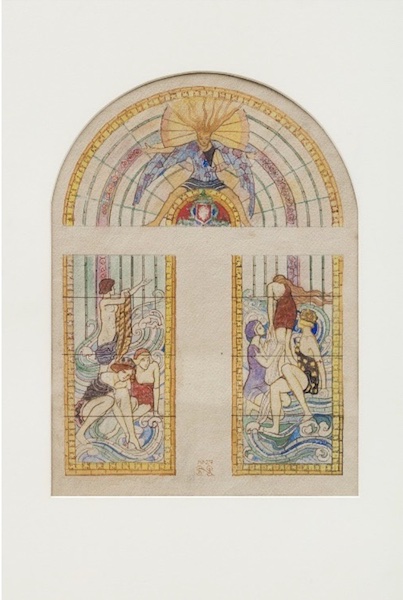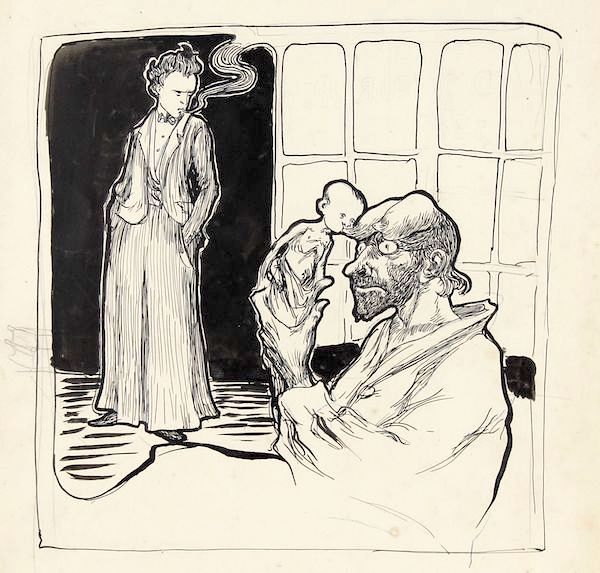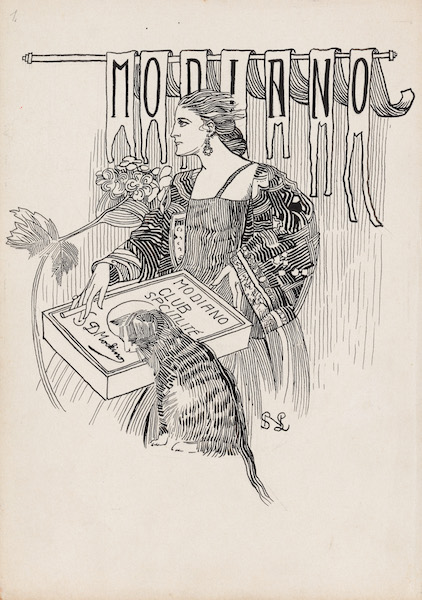Biography
Sándor Nagy (Németbánya, May 18, 1868 – Gödöllő, March 14, 1950) was a Hungarian painter and graphic designer. He was the embodiment of that type of artist who, while accepting anachronism, faithfully stuck to the ideals he found in his youth. In accordance with the Art Nouveau program, he cultivated several branches of art. Together with Aladar Körösfői-Kriesch, he is one of the founders of the Gödöllő artist colony. The artist colony The Gödöllő artist colony was created following the spirit of the English Arts and Crafts Movement, whose operation was based on the traditional unity of arts and crafts. The efforts and artistic ideas of the two shaped the image of this single organized association created in the spirit of the Hungarian Art Nouveau. Following Ruskin, they believed that "every manifestation of life must be given an artistic content", and they believed in the life-renewing and purifying role of art.
Sándor Nagy was born on May 18, 1868 in Németbánya, Veszprém County. His father was a farmer. Since they lived alone and thus he would not have been able to go to school, he avoided home at an early age: he studied in Veszprém, Győr and Budapest. For two years, he was a popular student of Bertalan Székely at the National Pattern Drawing School. (Székely wrote his letters reflecting his perception of art and moralizing, in which he emphasized the role of art in educating people, and these found fertile ground in the art of Sándor Nagy.) The decorativeness of Székely's late works, his "colorful, linear new speech" was also fulfilled in the work of his student.
From 1890, he was a scholarship holder in Rome for two years. In his later writings, we can read mainly about adventurous travels and the everyday life of the bohemian international society. In the Palazzo Venezia, he lived with Austrian and Hungarian painters: Rudolf Pacher, Troll, Ferenc Paczka, Ede Balló, Aladár Körösfői-Kriesch. focused on Italian Renaissance masters.
In 1892, he left for Paris and enrolled at the Julian Academy, where several Hungarians (Károly Ferenczy, István Csók, Béla Iványi-Grünwald) had already visited. At that time, József Rippl-Rónai and László Mednyánszky were in Paris. He recalled the time he spent here in his series of pen drawings entitled "Parisian Memories" made in the 20s, the bohemian world of young painters who flocked here from all over the world, and the hot atmosphere of student balls. He later wrote that rue de Copenhague 8 no. in his studio below, researching the task of art, he immersed himself in reading Tolstoy and the Gospels. He successfully participated in the poster competition announced by the Art et Décorotion magazine, one of the most important forums of the French Art Nouveau, "art nouveau". The dynamic, bold play of lines in his drawings already reveals his extraordinary drawing talent, recognized by his fellow students.
Among the popular and influential movements of the era, the activity of the Rose Croix group was particularly significant for his personality.[1] Mednyánszky drew his attention to this, their formal language saturated with mystical and symbolic content could be closer to Sándor the Great than Gauguin's synthesis or the innovative painting of the Nabis masters. In Paris, the exhibitions of the Pre-Raphaelites were a great success. In fact, Sándor Nagy also got to know the movement here: the art of William Morris and Burne-Jones. Aladár Körösfői-Kriesch and the later Gödöllő artists also considered the Pre-Raphaelites as their main role models. Paris was also the scene of great friendships. Here he met Leo Belmonté, who later became the best execution master of the weaving school in Gödöllő.
During his years in Paris, he returned home several times for vacations to Jenő Boér's diód mansion, where Kriesch worked during the summer. Here they became acquainted with Transylvanian folk art, which had such a great influence on Hungarian artists at the turn of the century. In 1897, they visited Transylvania together with Tudor-Hart, who drew their attention to the English cottage industry movement.
The Paris years ended with comparison. The effervescent artistic life and the diversity of his endeavors gave him a feeling of "Babelian confusion". Although he only writes about moral comparisons in his memoirs, the symbolic influences closely intertwined with mysticism can be strongly felt in his works. In 1900, after a seven-year stay in Paris, at the invitation of György Ráth - who in 1900 entrusted him with the preparation of the Hungarian material for the World Exhibition in Paris - he returned home for good. Two years after his return, he married Aladár Kriesch's sister, Laura. They settled in Veszprém, and from that time the development of Sándor Nagy's Art Nouveau artistic individuality can be expected. First realized by William Morris (1834-1896) the ideal of a new artist-craftsman was versatility. Sándor Nagy also worked in almost all genres. During his long life, he was involved in graphics, fresco painting, plaque patterning, glass window design, furniture, leather goods and tapestries.
The desire to renew art was also connected with the idea of the "aestheticization" of life and the task of art to educate people and shape society. This ethical pretension and content manifested itself unusually strongly in him. Therefore - as a result of the primacy of content - his works are often literary and illustrative in nature, and their form is difficult , and their composition was not always included in a decorative unit.
The Gödöllő settlement, the organization of which began in 1902, became the lifeblood of his wide-ranging activities. Aladár Körösfői-Kriesch bought the looms of the Nämeelemer factory, and invited the weaver Margit Guillaume to Gödöllő. And Sándor Nagy won over Leo Belmonté, his former partner, who, after his studies in Paris, found a home here for a long time with his family in 1905. Sándorék Nagy moved from Veszprém to Gödöllő in 1907 when they finished their studio building designed by the architect István Medgyaszay. Aladár Körösfői-Kriesch and Sándor Nagy shaped the life and everyday life of the settlement. Kriesch's views on art based on Ruskin and Sándor Nagy's Tolstoyanism brought the friendly group of artists living and visiting here into a spiritual unity. Their goal was not to develop a painting method, but to create a community life based on specific moral and aesthetic principles. Here the center was the weaving school, but in addition to tapestry design, all other genres found a home in their circle. Creators representing different viewpoints - and their regular art visitors - were connected by a general pursuit of decorative stylization and the acceptance of folk art inspiration.
1909 is an important date in the life of the Gödöllő settlement. At their group exhibition in the National Salon, the general public also got to know the artists working here and their works. In addition to Aladár Körösfői-Kriesch and Sándor Nagy, István Zichy, Ervin Raáb, Carla Undi, Árpád Juhász and Ferenc Sidló were also featured in the exhibition. Their ever-recurring epithet was formed: "Hungarian Pre-Raphaelites". After the ceremonial introduction, the everyday life of the colony and the weaving school continued. According to the memories of those who once visited there, the weavers, a few students studying weaving at the College of Applied Arts, and the artists who live or visit here are ideal they formed a community.
In the twenties, Sándor Nagy was the leading master of post-secession. He successfully participated in several exhibitions, such as the international exhibition in Leipzig (in 1927) and the graphic exhibition in Florence (in 1928). At his debut in London in 1927, as well as at his gallery exhibition in 1931, a large part of his rich and varied oeuvre was revealed to the public. However, his mostly destroyed frescoes made in the 1920s and 1930s show the stiffening and academicization of his style (the altar wall of the Miklós Horthy chapel, Ferenc József dormitory chapel). Contemporary criticism singled out his mural "On the Path of Wars" created for the former Premontre high school in Gödöllő, in which he returned to the timeless and legendary style of writing of his earlier works.
The First World War put an end to the further development of the artist colony. Its inhabitants were scattered. Leo Belmonte returned to France with his family. During the war, Aladár Körösfői-Kriesch and Sándor Nagy were among the founding members of the Céhbeliek society, founded in 1914. After the end of the war, the Gödöllő settlement suffered a great loss, Aladár Körösfői-Kriesch died in 1920. His students and Jenő Remsey, who returned to Gödöllő, organized new societies in which Sándor Nagy no longer participated; there remained a master of the post-secession who was related to the former, but continued on his own path.
He and his wife continued to run the weaving workshop. In their carpets, they have preserved the care of the processing and the delicacy of the color harmony of the vegetable dyes. Due to the lack of domestic orders, a lot of work was done abroad. The number of figurative carpets has dwindled. The tapestry made in honor of "Saint Francis of Assisi and the Eucharistic Congress" stands out among them.
From the war years onward, watercolor and pastel played an increasingly important role in Sándor Nagy's art. He was a founding member of the Association of Hungarian Watercolor and Pastel Painters and the Association of Hungarian Graphic Artists. From the second half of the twenties, like the post-impressionist masters associated with the Nagybánya tradition, he was preoccupied with problems of light. Fresh natural experiences and mystical moods were recorded in his watercolors. His college teaching was a significant chapter of his teacher-educator program, which was announced from the beginning. In 1934, he was invited by the College of Fine Arts, and for ten years he taught the Cennino Cenni and Kriesch method of fresco painting, as well as tapestry and mosaic making. Its graphics also provide surprises in this era. In the connected pages of the "Parisian Memories" and "Love" cycles, he returned to the problems of content and form at the end of the century, renewing his earlier aspirations.
During the Second World War, he believed in universal European culture and its - even if somewhat anachronistic, but preserved - harmonious world view. The true value of the frescoes in Pesterzsébet (1938-41) and the huge "Csorn parish church fresco" made between 1942 and 1943 can only be appreciated if we feel the importance of the moral example embodied in them.
Even before the painting of the church in Pesterzsébet, the "glass window designs of the church in Pacirtamez" were completed, but here the wall paintings were already finished by his student, Irén Vandrák, in 1946. Sándor Nagy became seriously ill from this year. He couldn't work, he didn't receive support, and so sometimes he didn't even need medicine. The news of his death on March 14, 1950 was not even reported in the newspapers. He was buried in Gödöllő.



